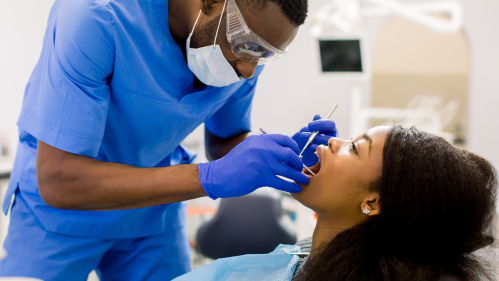How the Pandemic Highlights Barriers to Dental Care

The dean of Rutgers School of Dental Medicine discusses how people avoiding dental appointments during the pandemic is raising awareness of challenges in the dental health system
The number of Americans who have been unable to see the dentist during the pandemic has drawn attention to the importance of regular, accessible dental care. Cecile A. Feldman, dean of the Rutgers School of Dental Medicine, discusses how we can ensure that dental care is within reach for all.
How has COVID-19 affected Americans’ attitude toward oral health?
COVID has put a spotlight on the consequences of going without dental care. Not being able to see the dentist for months unless it was a dire emergency helped people realize how important it can be. Tooth infections that could have been caught early wound up abscessing. Patients who might have just needed a filling between visits required root canals. Dentists are often the first to detect oral cancer, and a lapse in appointments means some cases could have been caught sooner, improving the odds for early intervention and recovery. For people getting crowns or bridges, teeth shifted because they couldn’t see their dentist for work to be redone.
Many people have dirty teeth due to their putting off routine cleanings. Also, there is anecdotal evidence that indicates a rise in bruxism — the term for teeth grinding — because of the stress and anxiety caused by the pandemic.
Prior to the pandemic, what were some of the obstacles to accessing dental care?
For some Americans, geographical access is a problem: They don’t live close to a dentist. In many states, there are a shortage of dentists. Teledentistry, which has become widely used during the pandemic, could help partially fill that need. It could be used for preventive care: Dentists can call patients to ensure they are performing good oral health hygiene and then after checking in to reinforce the importance of oral healthcare.
For far too many patients, seeing a dentist is a financial problem. According to the American Dentistry Association, 33.6 percent of Americans lack dental coverage. Many have trouble affording care even with dental insurance, which, compared to medical insurance, often covers only a small portion of treatment costs. The situation improved with the Affordable Care Act (ACA) after it was approved in 2010. As a result, nearly 500,000 New Jerseyans had access to care that they didn’t have before due to ACA Medicaid expansions. But even under the ACA, dental care was only listed as an “essential” benefit for children.
What would make it easier for more people to get dental insurance and for that insurance to offer more coverage?
Employer health care coverage started out mostly in the 1960s as a way for industries to offer workers something without raising wages. Dentistry wasn’t a part of it because we have a bi-furcated system, where the health of a person’s mouth is somehow not regarded as part of their overall health. That needs to change. Oral health care needs to be seen as just another facet of physical health and wellbeing, and dentists and other oral health providers need to be covered the same way as others specialists, like ophthalmologists or cardiologists.
Organized dentistry initially resisted expanding Medicare and Medicaid to dental visits because they feared the government would force them to lower fees. Medicaid and Medicare still pay dentists extremely low rates compared to other providers. We don’t get paid much for screening or diagnosis. Dentists mainly get paid for actual treatment measures. In addition, there’s a big administrative burden that costs dental offices much time and energy. That must change. We also should reduce the need for documentation. Five different administrative companies are required to credential dentists where instead we could have one universal system for everyone one who has a valid license. We need to do everything we can do make sure affordable oral healthcare is available to everyone, and make the process of providing and obtaining it as easy as possible for both patients and dentists.
See how Rutgers is making a difference during the COVID-19 crisis.


